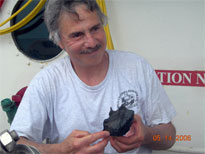OOI Mapping Cruise 2008
Newbies, Oldies and 21st Century Oceanography
There are always new experiences to be had going to sea. My work on the R/V Thompson this past week helping to operate the TowCam, and working with John and Debbie and the others on board to carry out the scientific and technical program reminded me about how satisfying it is to interact with others to solve problems and how the collective human and technical processes involved in oceanographic field work are what has sustained me for the nearly 40 years I have been doing this.
First – the ‘newbies’ – the young oceanography students seeking their first experience and suffering their first time truly at sea, rolling around, and trying to think and function in difficult circumstances. Mentoring and working with new students is always a pleasure and this last week’s cruise was no exception. The ‘Jules Vernian’ excitement of them working on the TowCam watches and then seeing the fruits of their labors in viewing the seafloor photographs – areas that likely no one else on this planet has ever seen, and may never see again. I believe that the stimulation to students on the cruise so far has been palpable, and that perhaps some will be nudged into oceanographic careers.
Oldies – somehow I can’t get used to the fact that often now I’m the oldest on board, including many in the ship’s crew. Over the years, I’ve recognized the immense satisfaction of working with exceptional people who dedicate their lives to supporting oceanography, from the ship’s captain, to the mates, chief engineer, engine crew, shipboard techs, and the steward, cooks, and able seamen – all critical to the expedition, and all dedicated to supporting our exploration of the oceans and revealing of its secrets in large and small ways. We could not do our work without them, so I never miss the opportunity to bestow kudos to them, in person and in print.
21st Century Oceanography – The techniques being used on this cruise are examples of 20th and 21st century oceanographic techniques. Taking photographs of the seafloor has been done since the early 20th century, although routine deep-sea photography started after the invention of the deep-sea strobe light source by Prof. Harold ‘Doc’ Edgerton of MIT in the middle of the 20th century. Digital deep-sea photography came to be near the end of that century. We’ve been doing it successfully for the past 10 or so years with exceptional results in terms of how that information can be routinely and quickly folded into decisions at sea about how to interpret the seafloor features or processes and what new tools are needed to better understand them. Then there is Sentry- truly the newest generation of oceanographic vehicle – the autonomous underwater vehicle (AUV) -capable of conducting pre-programmed missions to explore, map and sense the deep ocean and seafloor like no other system before it. Seeing the elegance and complexity of Sentry work in the deep ocean, and produce the data needed to understand the fine-scale topography of the ocean floor where the observatory nodes and cables will be deployed is truly a wonder – and a testament to the engineers responsible for its creation. And then there is the ocean observatory itself, John and Debbie’s vision for the new paradigm in oceanographic and earth sciences. This will certainly change how we view and understand the myriad processes at work in controlling ocean and earth-forming phenomena and their linkages.
John and Debbie are the ‘conductors’ of the orchestra at sea – keeping all the ‘instruments’ (that includes people, vehicles, the ship) all in harmony and tempo, in changing conditions (weather for one, cranky vehicle sensors for another…). It is a challenge. I was glad to play a small part in the performance so far. They are both doing a masterful job - bravo / brava. The intermission is over – can’t wait to see how the remaining performance plays out.
Related Content
Voices
- Newbies, Oldies and 21st Century Oceanography
- Going to Sea
- Once and Future Oceanographer
- The Oceans: Medicine Chest for the World
- When Your Home Bobs
- Seas of Opportunity
- Voices of the Fishes
- Oceanography as an Opportunity to Contribute
- The Water Column
- Ocean Heritage Guides this Oceanography Major
- Theater in the Round
